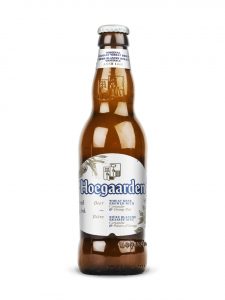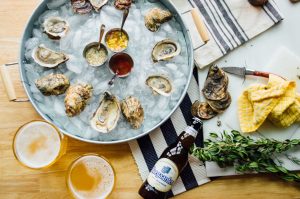27 Hoegaarden

Introduction
Hoegaarden – An unfiltered Belgian Witbier (ABV 4.9%). “Naturally cloudy with a pale golden color, followed by aromas and flavors of soft wheat, citrus, orange and coriander spice; delicately creamy with a smooth crisp, clean finish.” – LCBO, Hoegaarden Description
This beer named after a small village in the Flemish region of Belgium has both ancient history and a brewing secret that makes it an incredibly distinct beer. The brewers take smooth, sweet, and spicy ingredients, combine them together into a brew, and proceed to brew it once again. This recipe and process has been perfected over hundreds of years.

Origins & Key Milestones
In ancient times the common knowledge was that Belgian Witbier or Wheat Beer was sour. It was Monks in Hoegaarden who, in 1445, began to experiment and mix Curaçao Orange Peels and Coriander in with their Wheat. This process successfully continued on for hundreds of years. Over this long period of time Hoegaarden became one of the largest brewers of the 18th Century. By 1709 there were 12 functioning breweries in Hoegaarden and by 1758 there were 38; that was 1 brewery for every 58 of its 2,000 villagers. Even with this ancient religious tradition and global support, Belgium was hit very hard during World War Two. Just over a decade after the war ended Hoegaarden was forced to close down their last brewery. As of the 1950s, Hoegaarden’s 500 years of brewing had come to an end.
Then, 10 years after the closing of Hoegaarden’s last brewery, “Tomsin”, a Milkman by the name Pierre Celis began to follow the ancient traditional recipe and once again brew Hoegaarden in Hoegaarden. By the mid-70s to early-80s, Hoegaarden had gone fully international and has remained this to this day. For 577 years the monk’s recipe has remained the same.

Multimedia
Enjoy this video made by Charles Nouwen, where he visits Hoegaarden and expands on the beer as well as the village’s history!
https://www.youtube.com/watch?v=hu-qwP6zaTU&t=6s
Brewing Science and Industrialization
Hoegaarden, and almost all other breweries in Belgium, embraced industrialization with open arms. Hoegaarden and other major breweries like Stella Artois are some of the largest breweries on the planet (Stella being #2 in the World). Using everything from boats to advanced robotics malting facilities Belgium as an entire country is a very proud, history rich place that preserves the old while embracing the new. Hoegaarden undergoes a processes where extra sugars and yeast is added to the beer, and because of this they explain that the best way to enjoy it is by taking traditional bottle, pouring ⅓ of the beer into your glass, then moving the bottle in a circular motion in order to stir any remaining sediment. This process is key for drinking the beer, but upon industrialization Hoegaarden embraced using beer cans. The methods of brewing, distributing, and consuming Hoegaarden have all been influenced by industrialization but the taste and the Belgian pride stays the same.
Multimedia
Here you can watch a very well made video made by the LCBO detailing the history and current (2014) state of Belgian Beer. The entire 24 minute and 58 second video is worth the watch, but if it is Hoegaarden you are after, watch 12:20-15:30.
Beer Style
Hoegaarden was, history wise, revolutionary in regards to crafting beer in Belgium. For centuries Belgians crafted their beer in styles that were almost always very strong or even bitter. Even without knowing, when the Monks crafted the beer for the first time, they introduced a style of sweet, and citrus based beer. The style of beer influenced the country, Europe, and eventually the world. For six centuries the brewers of Hoegaarden took Wheat, Curaçao Orange Peels and Coriander to create one of the most distinct flavors of Beer Belgium had ever seen. Today, Belgium is known for its love and use of natural flavors, and how they manage to take this love and express it through their beer. Hoegaarden’s Orange flavor is a great example but they themselves along with other Belgian breweries take other ingredients to shake up the taste of their beers. Another famous Belgian style is to use Raspberries.
Multimedia
Here is a video that explains in great detail how Belgium’s style of brewing differs so much from similar countries like Germany.
Beer 101: German vs. Belgian Beer
The WW1 and WW2 Era
Both World Wars changed all of history. Every country, still to this day, is experiencing advances and setbacks that began because of the wars. For Belgium, WW1 and WW2 both served as a culling for their breweries. Geographically, Belgium was front and center for a very large portion of both World Wars. At its prime, Belgium had nearly 3200 breweries but by the end of the 1940s only 774 remained. After thriving and advancing over 6 centuries, all of Hoegaarden’s progress was destroyed. It was only after the country, and the world, had time to recover that Hoegaarden made its return. The impact of WW1 and WW2 can still be felt and seen today and one clear way of showing this is to look at the history of Hoegaarden.
Consolidation
Upon the end of WW2, and after Pierre Celis started brewing Hoegaarden again in 1965, the beer thrived. For 20 years this process continued until a horrible fire burned down the brewery, forcing Celis to turn to AB-InBev. Known for owning major breweries like Budweiser, Corona and even Belgium’s Stella Artois, the company is a colossally major player in the world of brewing. Many were upset due this change in ownership, but the change did ensure that the once great Hoegaarden was brewed at the same rate if not a faster rate than when it was in its prime before WW2. This decision took the once 100% Belgian brewed beer and made it something much more.
Marketing & Branding
While the scale and range of the beer changed, the marketing and branding did not. Still to this day Hoegaarden is known for its distinct bottles, the label’s patriotic color scheme, and their history rich logo. It was simply the scale of this marketing that skyrocketed. In 2020, Quebec based digital advertising agency, “Dreww” started a marketing campaign where all Dreww Creators would share posts on their Instagram accounts showcasing delicious meals that paired with Hoegaarden. A very different company, in a different era, on the other side of the world enjoying and showcasing the beer’s compatibility with food the same way the villagers and monks of Hoegaarden would.
Featured above is a photo example of a meal paired with Hoegaarden. Attached to said photo you will find a link leading you to a source where you can find out more about pairing the right food with the right beer!
Multimedia
Featured below is not only an example of a recipe that would go well with Hoegaarden, but a recipe that actually involves using Hoegaarden.
Cooking with Beer – Hoegaarden Mussels
Modern Era
Originally Hoegaarden was 100% Belgian brewed and sold. This international pride was greatly revered amongst Belgians, but this inclusivity also resulted in the breweries downfall. Today, Hoegaarden is enjoyed internationally and is often considered the global standard for the Belgian-white style of beer. AB-InBev took the beer and continued to make it as international as possible in order to keep up with the demands. In 2020, 575 years after Belgian Monks started to brew the recipe, AB-InBev started to brew Hoegaarden in India. This modern choice was to take advantage of India’s cost of labor, and as a result, AB-InBev saw the price of Hoegaarden go down by 26-57%. This drop has allowed AB-InBev to continue to compete against all their craft-beer competition as well as significantly help the company widen their consumer base.
References
- BeerTorism. (n.d.). World War II – BeerTourism.com. About Belgium | Beer Tourism. Retrieved March 13, 2022, from https://www.beertourism.com/blogs/about-belgium/world-war-ii
- Bell, E., & Saladino, E. (2018, June 15). 9 Things You Should Know About Hoegaarden. VinePair. Retrieved February 1, 2022, from https://vinepair.com/articles/hoegaarden-beer-hefeweizen-witbier/
- Cowden, A. (2013, November 15). The Man Who Invented Beer: Hoegaarden. Heave Media. Retrieved March 13, 2022, from http://www.heavemedia.com/2013/11/15/the-man-who-invented-beer-hoegaarden/
- Hoegaarden. (n.d.). Hoegaarden. Hand Family Companies. Retrieved February 1, 2022, from https://www.handfamilycompanies.com/hoegaarden
- It’s Who-Gaar-Den! Loved pairing this sweet Hoegaarden beer with 3 mignonette recipes for a little indoor oyster fest | bygabriella.co. (2016, October 13). By Gabriella. https://bygabriella.co/oyster-fest-hoegaarden-beer/hoegaardenoysterfest_37/
- Jennings, L. B., & Alison Brod Marketing + Communications. (2019, April 17). Forget Bikini-Clad Foam Parties, Hoegaarden Wants to Pay for You to Slow Down This Spring Break with a Trip to Hoegaarden, Belgium. Business Wire. Retrieved February 6, 2022, from https://www.businesswire.com/news/home/20190417005117/en/Forget-Bikini-Clad-Foam-Parties-Hoegaarden-Wants-to-Pay-for-You-to-Slow-Down-This-Spring-Break-with-a-Trip-to-Hoegaarden-Belgium
- LCBO. (n.d.). Hoegaarden. LCBO. Retrieved February 1, 2022, from https://www.lcbo.com/webapp/wcs/stores/servlet/en/lcbo/belgian-wit-16022060021/hoegaarden-554089#.Yf2bC-rMKUk
- LCBO. (2014, August 11). Discover Belgian Beer. YouTube. Retrieved March 13, 2022, from https://www.youtube.com/watch?v=420A9dja88I
- Malviya, S. (2020, December 2). Anheuser Busch InBev slash prices of its premium brands-Hoegaarden and Corona by 26–57%. The Economic Times. https://economictimes.indiatimes.com/industry/cons-products/liquor/anheuser-busch-inbev-slash-prices-of-its-premium-brands-hoegaarden-and-corona-by-26-57/articleshow/79517502.cms
- McClelland Premium Imports. (2014, December 4). Beer 101: German vs. Belgian Beer. YouTube. Retrieved March 13, 2022, from https://www.youtube.com/watch?v=f7yeYypTd2A
- Nouwen, C., & AB InBev. (2019, October 17). Hoegaarden Brewery | Belgium | AB InBev European Brewery Tour with Charles Nouwen. YouTube. Retrieved February 1, 2022, from https://www.youtube.com/watch?v=hu-qwP6zaTU&t=6s
- Savouring Perfection : Belgian Beer & Food Pairing. (n.d.). StarChefs.Com. https://www.starchefs.com/product_education/beer-and-food-pairing/html/index.shtml#:~:text=With%20its%20soft%20body%20and,the%20flavors%20found%20in%20Hoegaarden.
- Villa, K., The Oxford Companion to Beer, & Craft Beer & Brewing. (n.d.). Hoegaarden. Craft Beer & Brewing. Retrieved February 1, 2022, from https://beerandbrewing.com/dictionary/rirPYQpTS8/
- VISITFLANDERS. (n.d.). The history of Belgian beer. Visit Flanders. Retrieved March 13, 2022, from https://www.visitflanders.com/en/themes/belgian-beer/a-brief-history-of-belgian-beer/index.jsp
- Wikipedia. (n.d.). Hoegaarden Brewery. Wikipedia. Retrieved February 1, 2022, from https://en.wikipedia.org/wiki/Hoegaarden_Brewery
- YouTube [MJ Won]. (2021, July 1). Cooking with Beer | Hoegaarden Mussels | Hoegaarden Witbier | By MJ Won [Video]. YouTube. https://www.youtube.com/watch?v=i_W6GcQCIQU


